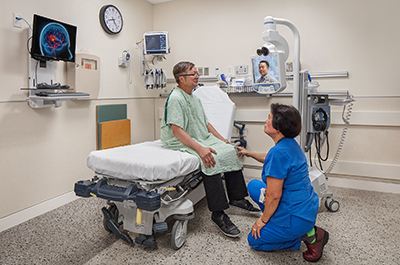Telemedicine Robot Saves 30-Year-Old Greg’s
Life After Sudden Surprise Stroke

When he was just 30 years old, Christina’s brother-in-law Greg came to the emergency room at Swedish Hospital with symptoms of a stroke. As a Primary Stroke Center with a telemedicine stroke partnership, the emergency team was ready when things took a turn for the worst. Due to their rapid response time and lifesaving technology, Greg not only cheated death, but now lives a healthy life free from side effects.
Ten years earlier, while attending university, Greg first noticed that something was wrong with his cardiovascular health. At times, his heart would flutter, race or skipped a beat. Worrying they might be symptoms of arrhythmia, he sought the advice of a local doctor.
“The doctor told him not to worry about it,” said Christina, who wanted to share his ordeal to help others. “He didn’t prescribe any medication or tell him to follow up with the condition down the road. He said it was likely stress related to exam week and would go away in time.”
It didn’t, but aside from occasional bouts of an irregular heartbeat, he tried his best not to think about it. Shortly after turning 30, that all changed.
“He woke up one morning feeling sort of strange,” said Christina. “He was dizzy and his left arm felt tingly so he had his wife drove him to the
emergency room. Swedish Hospital was the closest to his home in Lincoln Square.”
When he arrived, he was assessed by a triage nurse, who determined his symptoms were likely due to a stroke. Being a Primary Stroke Center, the emergency team knew time was of the essence. They immediately began treating him with clot-buster tissue plasminogen activator (tPA), the only drug approved by the FDA to treat ischemic stroke. If given intravenously in the first three hours after the start of stroke symptoms, tPA can significantly reduce the effects of stroke and lessen the chance of permanent disability.
The medicine helped temporarily, but soon after his condition began to rapidly grow worse. Knowing that he might need interventional surgery, they quickly consulted neurologists at a Comprehensive Stroke Center using the Emergency Department’s
telemedicine robot. The specialists at both institutions were in agreement, he needed to be transported to specialized surgery. Fast.
“As they were in the ambulance, Greg had a massive stroke,” said Christina. “The basilar artery was completely blocked. His entire left side was paralyzed, the right side was barely functional and breathing was becoming manual and difficult. Luckily, they were able to get him into surgery really quickly to get that released.”
The treatment was successful, but it was still unclear whether he would suffer from side effects. They began to prepare for the worst.
“The doctors at rush were explaining to his wife that he could be paralyzed, and that it was miracle he was alive,” said Christina. “They wanted to outline all of the possibilities of what could happen as a result of the stroke. Greg was awake and alert for the entire ordeal. During the thrombosis treatment he heard the doctors say they had removed the clot and immediately could feel the functions return to his body parts. Within the hour the only side effect was double vision and that was gone by the next morning.”
He stayed as an inpatient for only a couple nights. Following his discharge, he completed a short term leave from work for a few weeks, during which time he met regularly with his primary care physician and learned how to best take care of himself following this event. Over the next six months, Greg had two follow-up procedures consisting of cardioversion and
cryoablation to correct and
normalize his heart rhythm and prevent any further issues. Over a year later, he remains happy and healthy and side effect free.
“It’s a pretty amazing testament to the effectiveness of tPA and lifesaving technology like the telemedicine robot at Swedish Hospital,” said Christina. “If he was at a hospital that didn’t have these things, he could have died before getting to a Comprehensive Stroke Center. He’s extremely grateful to have the opportunity to live a perfectly healthy life where he can exercise and spend time with his wife and children.”
Click here to learn more about
cardiovascular or
pulmonary services at Swedish Hospital.
To learn more about Swedish Hospital’s award-winning stroke care, visit our
newsroom.
By David Modica | Published May 9, 2017

